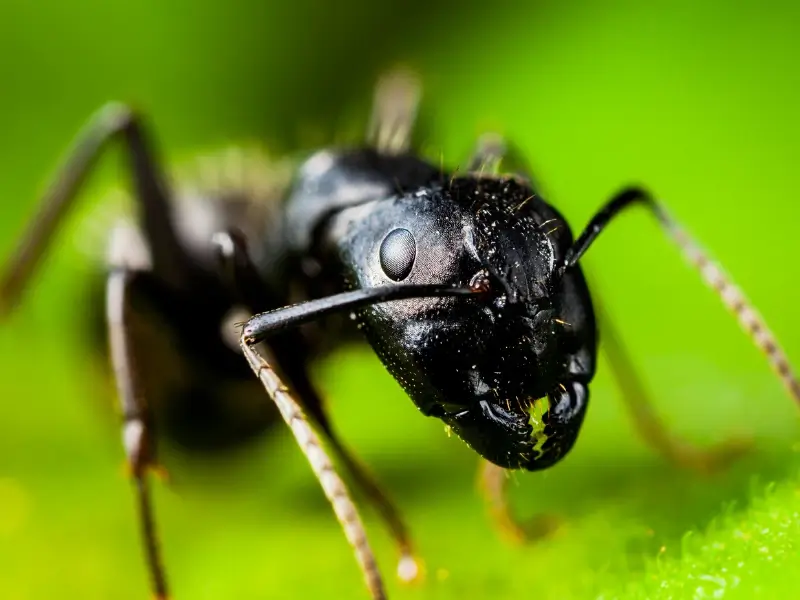
Carpenter Ants in North Carolina
Carpenter ants pose a significant threat to homes and structures in North Carolina. At A-1 Pest Control, we specialize in providing comprehensive ant control services to protect your property. Learn how to identify and eliminate carpenter ant infestations with our expert guidance.
Identifying Carpenter Ants
Carpenter ants are larger than many other ant species, typically measuring between 0.25 to 0.5 inches in length. They vary in color, ranging from red to black. One distinguishing feature of carpenter ants is their segmented body, with a narrow waist and elbowed antennae. Additionally, carpenter ants have powerful jaws, which they use to excavate wood for nesting purposes. Spotting sawdust-like material (frass) near wooden structures is a common sign of carpenter ant activity.

Life Cycle of Carpenter Ants
Understanding the life cycle of carpenter ants can provide valuable insights into effective control strategies. Carpenter ants undergo complete metamorphosis, progressing through four stages: egg, larva, pupa, and adult. The queen carpenter ant lays eggs, which hatch into larvae and develop into pupae before emerging as adult ants. This cycle repeats, with mature colonies producing winged reproductives, known as swarmers, to establish new colonies.
Behavior and Diet of Carpenter Ants
Behavior
Carpenter ants exhibit distinct behaviors that set them apart from other ant species. These ants are primarily nocturnal, meaning they are most active during the night. Carpenter ants are known for their ability to excavate wood to create smooth, clean galleries where they establish their nests. Unlike termites, carpenter ants do not consume wood; instead, they remove it to build their colonies.
Diet
Carpenter ants are omnivorous, feeding on a variety of substances. Their diet typically includes:
- Insects and other arthropods: Carpenter ants hunt and scavenge for other insects, which provide the protein necessary for the growth and development of their larvae.
- Sweet substances: They have a preference for sugary foods such as honeydew, which is a secretion from aphids and other plant-sucking insects. They may also feed on fruits and other sweet human foods.
- Plant material: While not their primary food source, carpenter ants may feed on plant juices and other plant-based substances.
Understanding the behavior and diet of carpenter ants is crucial for effectively managing and preventing infestations so that you can take better steps to keep them away from your home or business.
What Attracts Carpenter Ants
Carpenter ants are attracted to moist, decaying wood, making properties with water damage or wood rot particularly vulnerable to infestations. Common attractants for carpenter ants include:
- Moisture: Leaky pipes, clogged gutters, and poorly ventilated areas provide ideal conditions for carpenter ants to thrive.
- Woodpiles: Stacked firewood and untreated lumber serve as attractive nesting sites for carpenter ants.
- Food Sources: While carpenter ants primarily feed on other insects and sweet substances like honeydew, they may also scavenge for food in kitchens and pantries.
Identifying and eliminating these attractants is crucial for preventing carpenter ant infestations.
Damage Caused by Carpenter Ants
Carpenter ants are not only a nuisance pest but also a threat to the structural integrity of buildings. Unlike termites, carpenter ants do not eat wood but excavate galleries to create nesting sites. Over time, this tunneling activity can weaken wooden structures, leading to costly repairs. Identifying and addressing carpenter ant infestations early is essential for minimizing damage and preserving the structural integrity of your home.
Carpenter Ant Prevention Tips
In addition to professional pest control services, there are several steps homeowners can take to prevent carpenter ant infestations:
- Remove Wood Debris: Clear away dead wood, tree stumps, and decaying lumber from your property to eliminate potential nesting sites for carpenter ants.
- Maintain Gutters and Downspouts: Ensure gutters are clean and properly functioning to prevent water buildup, which can attract carpenter ants.
- Repair Structural Damage: Seal cracks, gaps, and holes in your home's foundation, walls, and roof to prevent carpenter ants from gaining entry.
- Store Firewood Properly: To reduce the risk of carpenter ant infestations, store firewood away from your home and elevate it off the ground.
- Trim Vegetation: Trim trees and shrubs away from your home to eliminate potential bridges for carpenter ants to access your property.
Implementing these preventive measures can reduce the risk of carpenter ant infestations and protect your home from damage.
How to Get Rid of Carpenter Ants
Effective carpenter ant control involves a combination of sanitation, exclusion, and professional pest control. Here are some steps you can take to address carpenter ant infestations:
Sanitation
- Eliminate Moisture: To reduce moisture in your home, repair leaky pipes, improve ventilation, and address water damage.
- Remove Food Sources: Store food in airtight containers, clean up spills promptly and dispose of garbage regularly to eliminate potential food sources for carpenter ants.
Exclusion
- Seal Entry Points: Seal cracks, gaps, and openings around doors, windows, and utility penetrations to prevent carpenter ants from entering your home.
- Trim Vegetation: Trim trees and shrubs away from your home to prevent carpenter ants from gaining easy access to your property.
Professional Pest Control
Professional pest control services are recommended for severe carpenter ant infestations. At A-1 Pest Control, our experienced technicians use advanced treatment methods to eliminate carpenter ants and prevent future infestations. Our treatments are safe for your family and pets, ensuring peace of mind.
Contact A-1 Pest Control in North Carolina for Carpenter Ant Control
Finding carpenter ants in your home or business can be overwhelming, especially when it’s an infestation. Though carpenter ants are small, their colonies can cause significant damage to wooden structures, compromising the integrity of your property. If you need help with carpenter ants or ant prevention in North Carolina, the experts at A-1 Pest Control can help.
We have offices in Lenoir, Hendersonville, Blowing Rock, West Jefferson, and Mooresville, but our exterminators serve much of the surrounding area.
Contact us today at 828-481-9140 or fill out the form below to learn more about our Home Shield pest control plans. Our exterminators will help you take care of carpenter ants—and many other creatures and critters that are best left outside! Schedule a free pest control inspection today.

